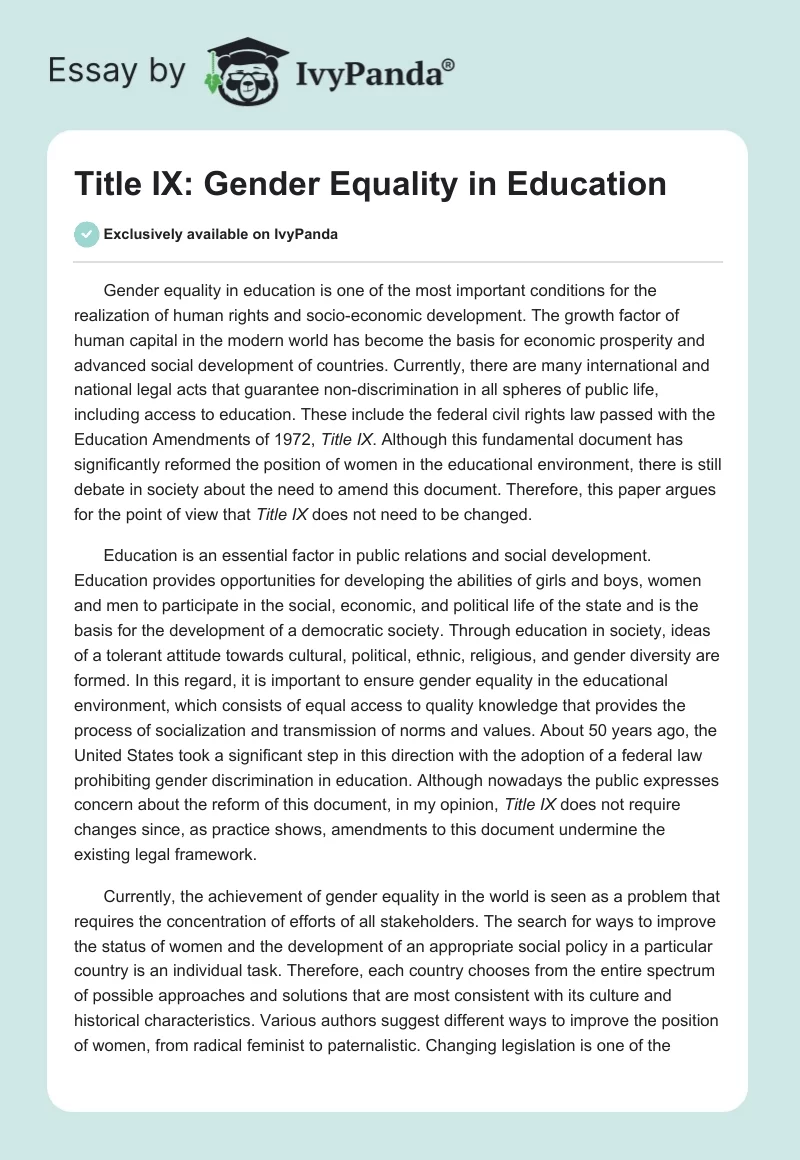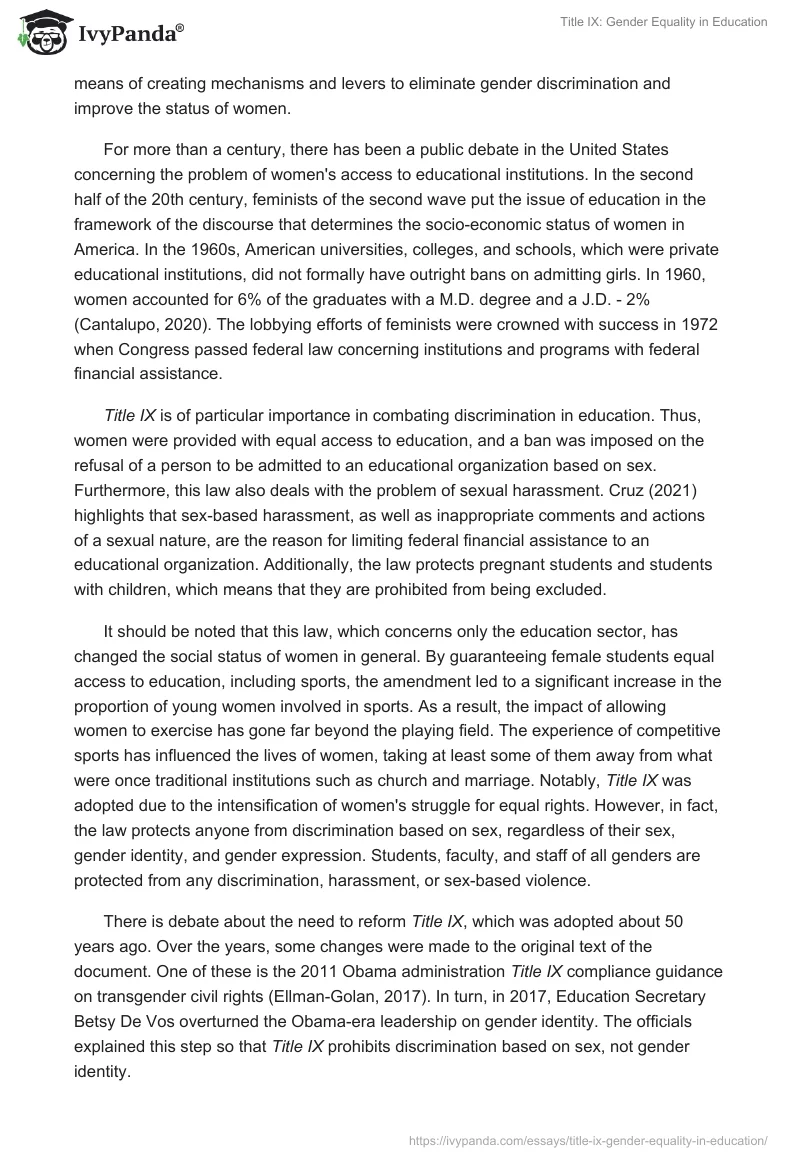Gender equality in education is one of the most important conditions for the realization of human rights and socio-economic development. The growth factor of human capital in the modern world has become the basis for economic prosperity and advanced social development of countries. Currently, there are many international and national legal acts that guarantee non-discrimination in all spheres of public life, including access to education. These include the federal civil rights law passed with the Education Amendments of 1972, Title IX. Although this fundamental document has significantly reformed the position of women in the educational environment, there is still debate in society about the need to amend this document. Therefore, this paper argues for the point of view that Title IX does not need to be changed.
Education is an essential factor in public relations and social development. Education provides opportunities for developing the abilities of girls and boys, women and men to participate in the social, economic, and political life of the state and is the basis for the development of a democratic society. Through education in society, ideas of a tolerant attitude towards cultural, political, ethnic, religious, and gender diversity are formed. In this regard, it is important to ensure gender equality in the educational environment, which consists of equal access to quality knowledge that provides the process of socialization and transmission of norms and values. About 50 years ago, the United States took a significant step in this direction with the adoption of a federal law prohibiting gender discrimination in education. Although nowadays the public expresses concern about the reform of this document, in my opinion, Title IX does not require changes since, as practice shows, amendments to this document undermine the existing legal framework.
Currently, the achievement of gender equality in the world is seen as a problem that requires the concentration of efforts of all stakeholders. The search for ways to improve the status of women and the development of an appropriate social policy in a particular country is an individual task. Therefore, each country chooses from the entire spectrum of possible approaches and solutions that are most consistent with its culture and historical characteristics. Various authors suggest different ways to improve the position of women, from radical feminist to paternalistic. Changing legislation is one of the means of creating mechanisms and levers to eliminate gender discrimination and improve the status of women.
For more than a century, there has been a public debate in the United States concerning the problem of women’s access to educational institutions. In the second half of the 20th century, feminists of the second wave put the issue of education in the framework of the discourse that determines the socio-economic status of women in America. In the 1960s, American universities, colleges, and schools, which were private educational institutions, did not formally have outright bans on admitting girls. In 1960, women accounted for 6% of the graduates with a M.D. degree and a J.D. – 2% (Cantalupo, 2020). The lobbying efforts of feminists were crowned with success in 1972 when Congress passed federal law concerning institutions and programs with federal financial assistance.
Title IX is of particular importance in combating discrimination in education. Thus, women were provided with equal access to education, and a ban was imposed on the refusal of a person to be admitted to an educational organization based on sex. Furthermore, this law also deals with the problem of sexual harassment. Cruz (2021) highlights that sex-based harassment, as well as inappropriate comments and actions of a sexual nature, are the reason for limiting federal financial assistance to an educational organization. Additionally, the law protects pregnant students and students with children, which means that they are prohibited from being excluded.
It should be noted that this law, which concerns only the education sector, has changed the social status of women in general. By guaranteeing female students equal access to education, including sports, the amendment led to a significant increase in the proportion of young women involved in sports. As a result, the impact of allowing women to exercise has gone far beyond the playing field. The experience of competitive sports has influenced the lives of women, taking at least some of them away from what were once traditional institutions such as church and marriage. Notably, Title IX was adopted due to the intensification of women’s struggle for equal rights. However, in fact, the law protects anyone from discrimination based on sex, regardless of their sex, gender identity, and gender expression. Students, faculty, and staff of all genders are protected from any discrimination, harassment, or sex-based violence.
There is debate about the need to reform Title IX, which was adopted about 50 years ago. Over the years, some changes were made to the original text of the document. One of these is the 2011 Obama administration Title IX compliance guidance on transgender civil rights (Ellman-Golan, 2017). In turn, in 2017, Education Secretary Betsy De Vos overturned the Obama-era leadership on gender identity. The officials explained this step so that Title IX prohibits discrimination based on sex, not gender identity.
Thus, the Ministry of Education announced the development of new amendments to the document regarding the provision of due process of law for students accused of assault. However, rather than providing adequate protection for the accused, these changes are intended to narrow the definition of sexual misconduct. Cruz (2021) asserts that if the persecution does not meet such criteria as severe and pervasive, the charge will be dismissed. In fact, this definition recognizes that any sexual misconduct that is a less palpable form of violence is an acceptable act. This fact contributes to the maintenance and dissemination of a culture of violence both in the educational environment and in society as a whole. Moreover, according to Cruz (2021), the new rules only allow educational organizations to investigate incidents that have occurred on campus and in student residences, and at off-campus educational events. This raises the question of how incidents that have occurred, for example, outside the country during a training program abroad, will be dealt with. Therefore, such changes have the potential to harm victims of discrimination by providing them with a minimum opportunity to receive assistance after an attack.
In the context of discussing the need to reform Title IX, it seems essential to touch upon such an aspect as gender stereotypes. They are formed through family education, the education system, the media, and established cultural traditions. The presence of gender stereotypes in society contributes to the fact that traditional behavioral gender roles are preserved in the public consciousness. They form certain types of thinking and behavior of men and women, depending on their gender in various social situations, which gives rise to gender stratification. This phenomenon, in turn, leads to an unequal distribution of socially valuable resources between men and women in society, reflecting different positions in the social hierarchy. According to Kollmayer et al. (2018), gender stereotypes both in education and subsequently in the labor market lead to vertical segregation and so-called glass ceiling and sticky floor phenomena. In this regard, it seems more expedient to pay attention to educational measures instead of carrying out inappropriate legislative reforms, including those concerning the content of Title IX.
Thanks to revisions, Title IX is more controversial than ever before. The evolutionary history of this document is a cautionary story of how good intentions and widely shared goals can be distorted over time by aggressive cultural struggles. Thus, as practice shows, amendments to the Title IX text are ineffective and undermine the existing foundations of protection against discrimination based on sex in education. Gender discrimination in the educational environment is a problem associated not so much with the shortcomings of legal regulation but with a low level of legal awareness and morality of citizens. This, in turn, makes it possible for occasions such as sexual violence, unequal access to educational resources, and all kinds of infringements of human rights. In this regard, it is essential to concentrate efforts on the educational policy of the population and not on reforming legislation, which over 50 years of its existence has brought many positive changes to society. Hence, the Title IX must be presented as we can see it for now, leaving the background and history associated with the name well.
References
Cantalupo, N. C. (2020). Title IX & The civil rights approach to sexual harassment in education. Roger Williams University Law Review, 25(2), 225-241.
Cruz, J. (2021). The constraints of fear and neutrality in Title IX administrators’ responses to sexual violence. The Journal of Higher Education, 92(3), 363-384.
Ellman-Golan, E. (2017). Saving Title IX: Designing more equitable and efficient investigation procedures. Michigan Law Review, 116(1), 155-186.
Kollmayer, M., Schober, B. & Spiel, C. (2018). Gender stereotypes in education: Development, consequences, and interventions. European Journal of Developmental Psychology, 25(4), 361-377.


